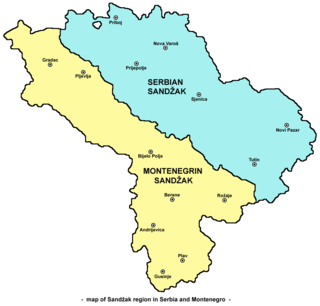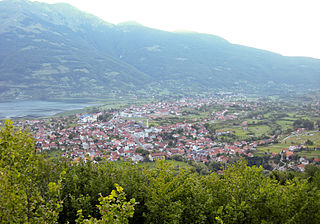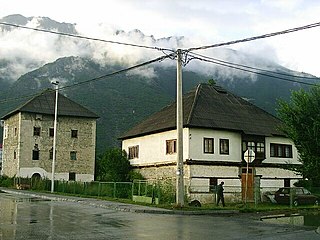
Sandžak is a historical geo-political region located in the southwestern part of Serbia and the eastern part of Montenegro. The name Sandžak derives from the Sanjak of Novi Pazar, a former Ottoman administrative district founded in 1865.
The demographic history of Montenegro can be shown through census results and official documents which mention demographic composition.

The Vasojevići is a historical highland tribe (pleme) and region of Montenegro, in the area of the Brda. It is the largest of the historical tribes, occupying the area between Lijeva Rijeka in the South up to Bihor under Bijelo Polje in the North, Mateševo in the West to Plav in the East. Likely of Albanian origin, most of the tribe's history prior to the 16th century has naturally been passed on through oral history.

Plav is a town in Montenegro in the northern region. It has a population of 3,717. Plav is the centre of Plav Municipality.

Gusinje is a small town in Montenegro in the northern region. According to the 2011 census, the town has a population of 1,673 and is the administrative center of Gusinje Municipality.

Rožaje is a town in Montenegro in the northern region.
Albanians in Montenegro are ethnic Albanians who constitute 4.91% of Montenegro's total population. They belong to the ethnic Albanian sub-group of Ghegs, and they are the largest non-Slavic ethnic group in Montenegro.

Kelmendi is a historical Albanian tribe (fis) and region in Malësia and eastern Montenegro. It is located in the upper valley of the Cem river and its tributaries in the Accursed Mountains range of the Dinaric Alps. The Vermosh river springs in the village of the same name, which is Albania's northernmost village. Vermosh pours into Lake Plav.

Islam in Montenegro refers to adherents, communities and religious institutions of Islam in Montenegro. It is the second largest religion in the country, after Christianity. According to the 2011 census, Montenegro's 118,477 Muslims make up 20% of the total population. Montenegro's Muslims belong mostly to the Sunni branch. According to the estimate by the Pew Research Center, Muslims have a population of 130,000 (20.3%) as of 2020.

Kuči is a tribe of Albanian origin, historically located in modern central and eastern Montenegro, north-east of Podgorica, extending along the border with Albania. Processes of Slavicisation during the Ottoman era and onwards facilitated ethno-linguistic shifts within much of the community. As such, people from the Kuči today largely identify themselves as Montenegrins and Serbs, with a minority still identifying as Albanians. In other areas such as the Sandžak, many Muslim descendants of the Kuči today identify as Bosniaks.

Hoti is a historical Albanian tribe (fis) and sub-region of Malësia, a divided area located in northern Albania and southern Montenegro. Its geography is mostly mountainous, but some of its villages are on flat terrain near the banks of Lake of Shkodër.

Vermosh is the northernmost village of Albania, located in the former Kelmend municipality. At the 2015 local government reform it became part of the municipality Malësi e Madhe. The village lies in a valley of the Albanian Alps, along a river with the same name.
Darza is a village in the municipality of Ulcinj, southeastern Montenegro. It is a multi-ethnic settlement, inhabited by Montenegrins, Serbs and Albanians.

Sadri Ahmeti was an Albanian painter and poet from Vusanje, Plavë, Gusinje of Montenegro.

Gusinje Municipality is a municipality in northern Montenegro. It is located in the upper Lim valley at an elevation of about 1,000 m (3,000 ft). It was created in 2014, when it split from Plav Municipality. Its center is the small town of Gusinje, and its biggest village in terms of territory is Vusanje. Two of Montenegro's highest mountains overlook Gusinje: Zla Kolata and Visitor. Many of Gusinje's settlements are historically linked with the Albanian Kelmendi tribe (fis). The village of Gusinje developed into a town the 17th century around a fortress built by the Ottomans to contain the Kelmendi. In the 19th century, Gusinje was a developing regional market center. It was engulfed in 1879–1880 in a struggle between the Principality of Montenegro that wanted to annex it and the League of Prizren that opposed it. After the Balkan Wars, Gusinje became part of Montenegro and in 1919 part of Yugoslavia. Today, it is part of Montenegro since its declaration of independence in 2006.
Ahmet Zenel Gjonbalaj or Ahmet Zeneli (1803–1893) was an Albanian fighter and commander during the period of the Albanian National Awakening in the 19th century who fought against the Principality of Montenegro's attempts to annex his homeland, Plav-Gusinje, alongside Ali Pasha of Gusinje and other Albanian patriots.
Bosniakisation designates the process of ethnic and cultural assimilation of non-Bosniak individuals or groups into the Bosniak ethnocultural corpus. Historically, bosniakisation was directed mainly towards some other South Slavic groups, like ethnic Muslims (Muslimani) in former Yugoslavia. Since Bosniaks are Sunni Muslims, Bosniakisation was also manifested towards some distinctive ethnoreligious minorities within Serbian and Croatian national corpus, mainly towards Serbian Muslims and Croatian Muslims.
Grnčar is a village in the municipality of Gusinje, Montenegro. It is located close to the Albanian border.
Martinovići is a village in the municipality of Gusinje, Montenegro.
Višnjevo is a village in the municipality of Gusinje, Montenegro.









